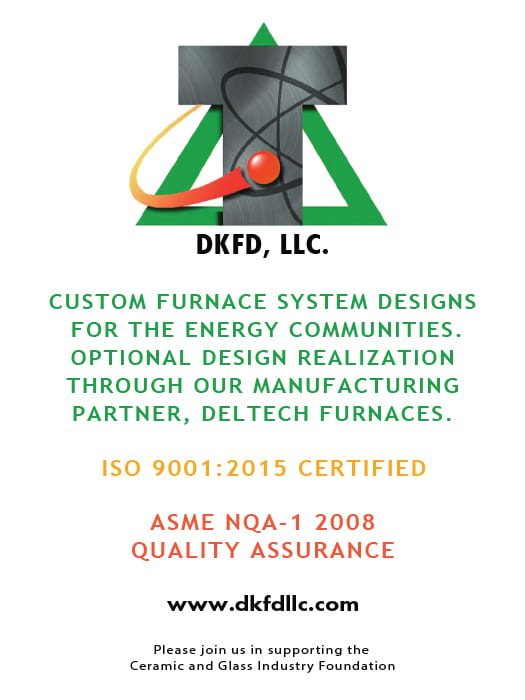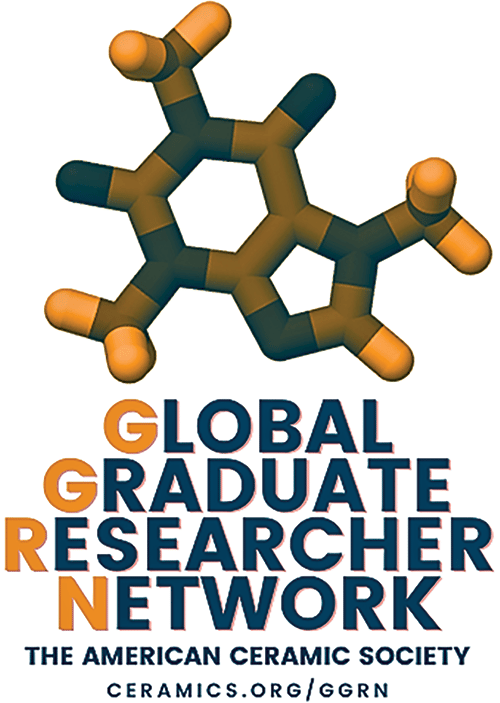acers spotlight
Society/Division/Section/Chapter News
For more information: ceramics.org
Welcome new ACerS Corporate Partners
ACerS is pleased to welcome its newest Corporate Partners.
To learn about the benefits of ACerS Corporate Partnership, contact Marcus Fish, director of development and industry relations, at 614-794-5863 or mfish@ceramics.org.

Central Ohio Section holds clay throwing event
The Central Ohio Section held its first annual clay throwing event on May 19, 2023, at the Hands-On Art Barn in Galena, Ohio. ACerS members received instruction on how to make a clay product using the wheel.


ACerS members at the clay throwing event in Galena, Ohio.
Attend your Division business meeting at MS&T23
Six of ACerS Divisions will hold executive and general business meetings at ACerS Annual Meeting at MS&T23 in Columbus, Ohio. General business meetings will be held Monday or Tuesday in the Greater Columbus Convention Center. Plan to attend to get the latest updates and to share your ideas with Division officers.
Monday, Oct. 2
- Glass & Optical Materials Division: 11 a.m.–12 p.m.
- Electronics Division: Noon–1 p.m.
- Engineering Ceramics Division: Noon–1 p.m.
- Bioceramics Division: 2–2:30 p.m.
- Energy Materials and Systems Division: 5:30–6:30 p.m.
Tuesday, Oct. 3
- Basic Science Division: Noon–1 p.m.
ACerS Italy International Chapter co-organized 10th KMM-VIN Industrial Workshop
The ACerS Italy International Chapter collaborated with the European Virtual Institute on Knowledge-based Multifunctional Materials (KMM-VIN) to successfully organize the 10th KMM-VIN Industrial Workshop “Advanced materials for energy: challenges and opportunities.” The workshop took place at Politecnico di Torino, Italy, on May 11–12, 2023.
Under the coordination of Politecnico di Torino professor Federico Smeacetto and other university colleagues, the workshop provided a platform for renowned experts from both industry and academia to engage in discussions regarding the latest advancements in the field of advanced materials for energy and associated technologies. The event attracted a substantial number of attendees, with more than 50 active participants, including senior and young researchers, industry professionals, and students.

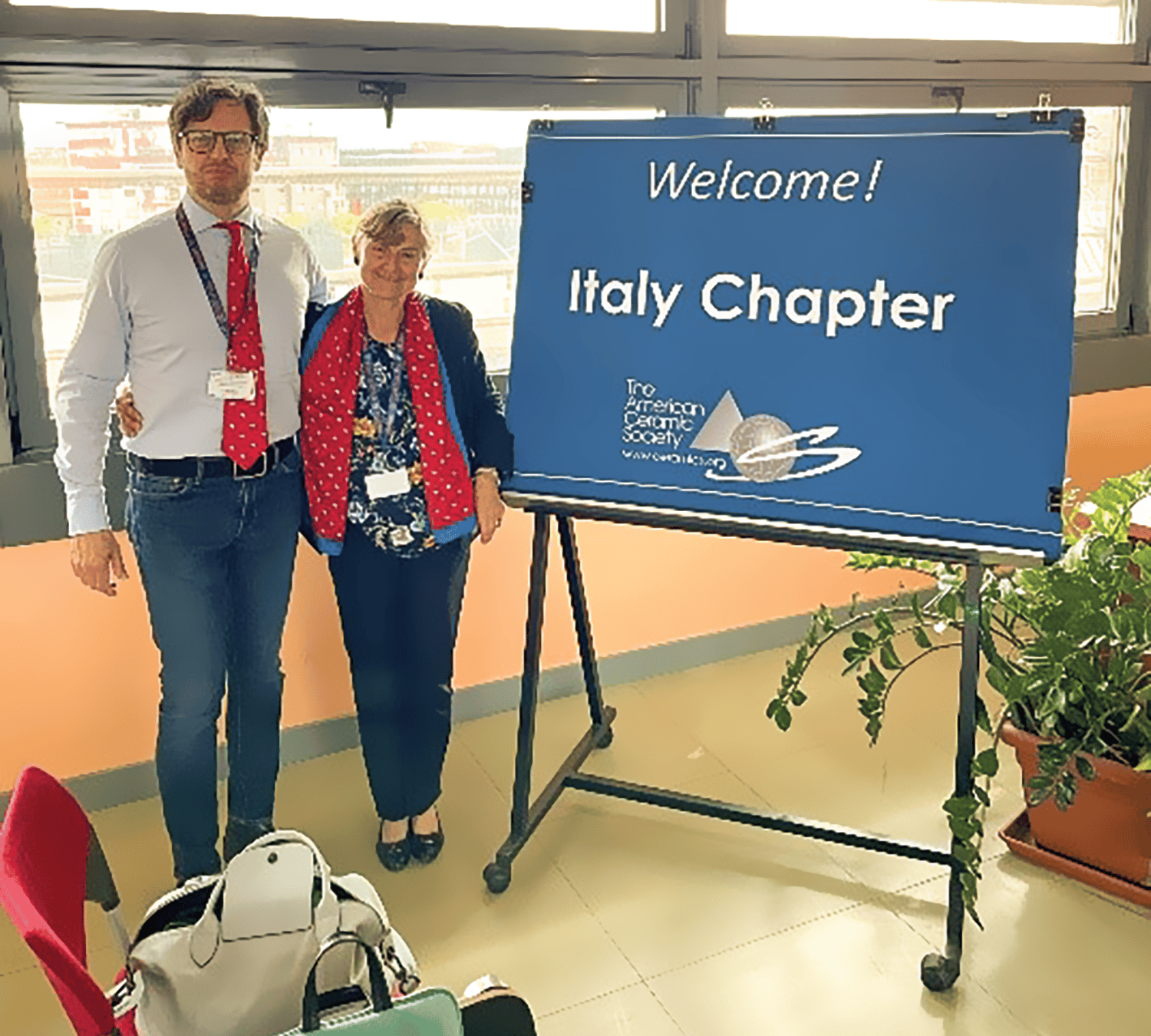
ACerS president-elect Monica Ferraris, right, with ACerS member Federico Smeacetto.
Award winners, left to right: E. Zanchi, C. Malinverni, and G.H.O. Marcatto.

Attendees of the 10th KMM-VIN Industrial Workshop at Politecnico di Torino, Italy.
The Chapter generously sponsored poster awards, recognizing exceptional contributions in the field. The winners of these awards were
- First place: C. Malinverni, Politecnico di Torino, Italy. Joining of ceramic matrix composites that operate under extreme conditions using glass-ceramics
- Second place: G. H. O. Marcatto, TU Graz, Austria. Fully additive manufacturing of PC/AlSi10Mg hybrid joints with surface structured substrate: a promising approach for lightweight applications
- Third place: E. Zanchi, Politecnico di Torino, Italy. Integration of glass-based sealings with metallic interconnects in solid oxide cell stacks
In Memoriam
- William Evans
- Robert Ingel
Some detailed obituaries can also be found on the ACerS website.
Welcome new ACerS International Chapters
Welcome to the newest ACerS International Chapters! The ACerS Board of Directors recently approved a petition to establish Chapters in the following countries.
Nordic Chapter
The Nordic Chapter will encompass Denmark, Finland, Iceland, Norway, and Sweden. Chapter officers are
- Chair: Yogendra Kumar Mishra, University of Southern Denmark
- Treasurer: Sandeep Thouti, University of Southern Denmark
- Secretary: Gunnar Weston, Uppsala University
Turkey Chapter
Chapter officers are
- Chair: Ender Suvaci, Eskisehir Technical University
- Treasurer: Ayşe Tunalı, VitrA
- Secretary: Caner Durucan, METU
India Chapters
Additionally, the ACerS India Chapter has been split into two regional chapters: the Northeast India Chapter and the Southwest India Chapter.
The Northeast Chapter will include Uttar Pradesh; Haryana; Delhi; Punjab; Himachal; Pradesh; Rajasthan; Gujarat; Jammu & Kashmir; Bihar; West Bengal; Tripura; Meghalaya; Orissa; Manipur; Nagaland; Uttarakhand; Chhattisgarh; Madhya Pradesh; Daman; Diu; Chandigarh; Arunachal Pradesh; Jharkhand; Assam; Mizoram; and Sikkim. The officers of the Northeast Chapter are
- Chair: Lalit Kumar Sharma, Mahanana Ceramic Development Organizational
- Treasurer: Preeti Kumari, IIT (BHU)
- Secretary: Asha Anil, Central Glass and Ceramic Research Institute
The Southwest Chapter will include Andhra Pradesh; Telangana; Karnataka; Tamil Nadu; Pondicherry; Goa; Kerala; Maharashtra; Lakshadweep; and Andaman Nicobar. The officers of the Southwest Chapter are
- Chair: C. D. Madhusoodana, Bharat Heavy Electricals Limited
- Treasurer: S. Chandrashekar, Saptha Group
- Secretary: Ravi Kumar, Indian Institute of Technology Madras
Contact Vicki Evans at vevans@ceramics.org for more information about these new Chapters or to form a Chapter in your region.
Remembering ACerS past president John B. “Jack” Wachtman, Jr.
The American Ceramic Society has lost an esteemed member—John B. “Jack” Wachtman died on Dec. 13, 2023, at the age of 94. He is predeceased by his wife, Edith V. Wachtman.
Wachtman grew up in the small town of Conway, S.C., where he attended public schools. During his early school years, Wachtman was influenced by the discovery of geometry, algebra, and physics. He applied for and received a scholarship from Carnegie Institute of Technology (now Carnegie Mellon University) in Pittsburgh, Pa.
Wachtman received B.S. and M.S. degrees in physics from Carnegie Tech and was a research and teaching assistant there from 1949–1951. Wachtman stated in his memoir that “my time at Carnegie was perhaps the highlight of my life. I loved the intellectual life and companionship of the students. The curriculum was designed to give scientists and engineers some degree of liberal arts education to the extent that this was possible.”
Wachtman joined the National Bureau of Standards (NBS, now the National Institute of Standards and Technology [NIST]) in 1951 as a physicist in the Engineering Ceramics Division. He received his Ph.D. in physics from the University of Maryland in 1961.
Wachtman left NBS in 1983 and began a second career as the first director of the Center for Ceramic Research at Rutgers, The State University of New Jersey–New Brunswick. During his 12 years at Rutgers, Wachtman taught courses on characterization and mechanical properties of ceramics intended for seniors and incoming graduate students.
After retiring from Rutgers, Wachtman wrote books based on the courses he taught. One of these books, Mechanical properties of ceramics, was published in 1996; a revised, second edition that was co-authored with his Rutgers colleagues Roger Cannon and John Matthewson published in 2009. These books were well received, with the first book selling 500 copies in the first six months. According to George Quinn (retired, NIST), these books are by far the best and most balanced textbooks on the topic.
In 1989, Wachtman took on the part-time role as technical editor for ACerS publications, a position he held for 12 years. During this time, his principal focus was on Journal of the American Ceramic Society. In his final year as editor, he, along with ACerS staff, succeeded in putting JACerS online with a subscription system. According to Mark Mecklenborg, ACerS executive director, “Having Dr. Wachtman involved in this process was essential. His knowledge, expertise, and commitment to the Society positioned the journal for success for many years to come.”
One of Wachtman’s final contributions to ACerS was editing the book Ceramic innovations in the 20th century. This book, published in 1999, coincided with the 100th anniversary of the founding of ACerS.
Wachtman collected a multitude of honors from various organizations, including NBS. In his memoir, Wachtman mentioned that the most meaningful honor to him was the election to the International Academy of Ceramics in 1988, as well as serving as president of The American Ceramic Society (1978) and the Federation of Materials Societies (1975). He was a Distinguished Life Member and an ACerS Fellow.
Wachtman was such an inspiration to so many people that it is fitting he ends his memoir with this closing quotation by polymath Albert Schweitzer: “At times our own light goes out and is rekindled by a spark from another person. Each of us has cause to think with deep gratitude of those who have lit the flame within us.”
Editor’s notes:
ACerS appreciates NIST Library for sharing the “Oral history interview of John B. Wachtman,” Feb. 4, 2010, and Wachtman’s 24-page “Memories and reflections on a career as a scientist-engineer in research management, teaching, and editing,” 2009, revised 2010.
Wachtman also featured in the December 1999 Ceramic Bulletin (Vol. 78, No. 12), pp. 36–41, “Profiles in ceramics” by Kathy Woodward.

John B. “Jack” Wachtman, Jr.
Adrian C. Wright, Distinguished Life Member, 1944–2023
Adrian Carl Wright, ACerS Distinguished Life Member and ACerS Fellow, died on March 22, 2023, at the age of 79. Wright, who dedicated his research career to understanding glass structure, was a member of the Glass & Optical Materials Division and also active in the Society for Glass Technology, where he served as the 49th president from 2002–2004.
Wright was professor of amorphous solid-state physics at the University of Reading, U.K. He earned his B.Sc. in chemistry, Ph.D. in physical chemistry, and D.Sc. degrees from the University of Bristol, U.K. After completing his Ph.D. studies, he took a position in 1969 at the University of Reading, where he remained until his retirement as professor emeritus in 2007.
He spent three sabbatical years in the United States working at leading institutions, including Xerox Palo Alto Research Center; Stanford Synchrotron Radiation Laboratory; Argonne National Laboratory; University of California, Los Angeles; University of Florida; and New York State College of Ceramics at Alfred University.
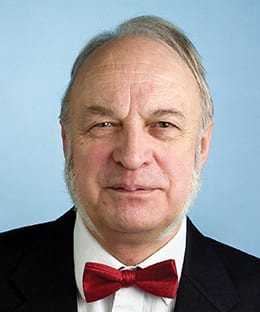
Adrian C. Wright
Wright pioneered use of neutron scattering and modeling studies to understand the structure and dynamics of a wide range of inorganic glasses and other amorphous solids, including silicate, borate, borosilicate, phosphate, chalcogenide, and fluoroberyllate glasses. He had more than 200 publications in the scientific literature, and he sat on the editorial boards of Journal of Non-Crystalline Solids and Fizika i Khimiya Stekla (Soviet/Russian Journal of Glass Physics and Chemistry).
Wright received several prestigious awards, including Fellow in 1995 of both ACerS and the Society of Glass Technology. In 1990, he shared the Worshipful Company of Glass Sellers of London Award, and in 1996, he received the ACerS Glass &
Optical Materials Division George W. Morey Award for his establishment of the field of amorphography. He presented the 2006 Samuel R. Scholes Lecture at the New York State College of Ceramics at Alfred University, and he was made an Honorary Fellow of the Society of Glass Technology in 2009.
Most recently, he shared the 2012 Otto Schott Research Award for “his lifelong outstanding scholarly work devoted to the experimental study of glass structure in general.” In 2014, he presented the ACerS Edward Orton Jr. Memorial Lecture, titled “My borate life: An enigmatic journey,” at ACerS Annual Meeting at MS&T in Pittsburgh, Pa. He served on the Steering Committee and Council of the International Commission on Glass. In 2016, he was designated an ACerS Distinguished Life Member.
“He was the consummate scientist and had many original ideas. He was productive until the end of his life,” says colleague Steve Feller, B.D. Silliman Professor of Physics at Coe College, Iowa.
Volunteer spotlight
ACerS Volunteer Spotlight profiles a member who demonstrates outstanding service to the Society.
Young-Wook Kim is professor of materials science and engineering at the University of Seoul, Republic of Korea. He received an M.S. and Ph.D. in materials science and engineering from the Korea Advanced Institute of Science and Technology and a B.S. in ceramic engineering from Yonsei University. Before joining the University of Seoul in 1996, he worked as a senior research scientist at the Korea Institute of Science and Technology.
Kim has authored or co-authored more than 330 journal articles and holds about 60 issued patents. He is an academician from the World Academy of Ceramics, a fellow of ACerS, and an honorary fellow of the European Ceramic Society. He received the John Jeppson Award, Samuel Geijsbeek PACRIM International Award, Global Star Award, and Global Ambassador designation from ACerS.
In addition to being a founding member of the ACerS Korea Chapter, Kim is chair-elect of the Engineering Ceramics Division and editor-in-chief of International Journal of Applied Ceramic Technology.
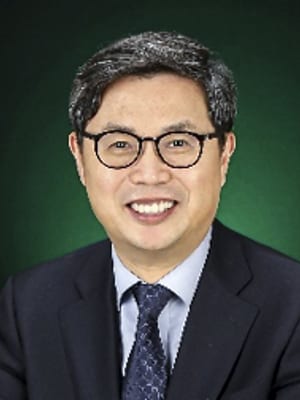
Young-Wook Kim
Shiho Kawashima is associate professor of civil engineering and engineering mechanics at Columbia University, N.Y. Her core areas of expertise are in cement and concrete, with a focus on rheology and processing, materials characterization, and alternative cements/clinkers. She received her B.S. in civil engineering and engineering mechanics at Columbia University, and her M.S. and Ph.D. in structural engineering and materials at Northwestern University. She joined Columbia University as an assistant professor in 2013.
Kawashima is an active member of ACerS, serving as past president of the Cements Division and co-chair of the 2022 and 2023 Annual Meetings. She is also an active member in the American Concrete Institute (ACI) and the International Union of Laboratories and Experts in Construction Materials, Systems, and Structures (RILEM). She serves on the editorial board for the American Society of Civil Engineers’ Journal of Materials in Civil Engineering, ASTM’s Advances in Civil Engineering Materials, Cement and Concrete Research, ACI Materials Journal, and RILEM Technical Letters.
Kawashima received an NSF CAREER Award on the topic of 3D concrete printing in 2017 and the ACerS Cements Division Early Career Award in 2022.
We extend our deep appreciation to Kim and Kawashima for their service to our Society!

Shiho Kawashima
Names in the news
Mrityunjay Singh, FACerS, DLM, chief scientist at the Ohio Aerospace Institute, was recognized with a third Honorary Doctorate from AGH University in Krakow, Poland (pictured). He also received the NASA Outstanding Public Leadership Medal at NASA Glenn.
Deborah D.L. Chung, professor in the Department of Mechanical and Aerospace Engineering at the University of Buffalo, was named a Fellow of the American Academy of Arts and Sciences.
Cato T. Laurencin, FACerS, Albert and Wilda Van Dusen Distinguished Endowed Professor of Orthopaedic Surgery and professor of chemical and biomolecular engineering, materials science and engineering, and biomedical engineering at the University of Connecticut, was named the recipient of the Inaugural DEI Award of the Society for Biomaterials.



Cato T. Laurencin
Deborah D.L. Chung
Mrityunjay Singh
Awards and Deadlines
For more information: ceramics.org/members/awards
2024 Class of Fellows nominations: Deadline is Jan. 15, 2024
The 2024 Class of Society Fellows recognizes members who have made outstanding contributions to the ceramic arts or sciences through productive scholarship or conspicuous achievement in the industry or by outstanding service to the Society. Nominees shall be people of good reputation who have reached their 35th birthday and who have been members of the Society at least five years continuously. Questions may be directed to Erica Zimmerman.
Do you qualify for Emeritus membership?
If you will be 65 years old (or older) by Dec. 31, 2023, and will have 35 years of continuous membership in ACerS, you are eligible for Emeritus status. Note that both criteria must be met. Emeritus members enjoy waived membership dues and reduced meeting registration rates. To verify your eligibility, contact Erica Zimmerman.
Nominations for Division Awards
- Deadline: Nomination deadlines for Division awards are XXX
- Contact: Karen McCurdy
Nominations for Society Awards
- Deadline: Nomination deadline is XXX
- Contact: Email Erica Zimmerman or call 614.794.5821.
Students and Outreach
For more information: ceramics.org/resources-for-students
Material Advantage student competitions
Learn more about each contest and find out how to enter at https://bit.ly/MSTstudentactivities.
Undergraduate Student Poster Contest
The Undergraduate Student Poster Contest provides an opportunity for students to put their communication skills to work by presenting their undergraduate research. Cash prizes will be awarded in the amounts of $250, $150, and $100. All undergraduate students may participate. To enter, submit an abstract of no more than 150 words by Sept. 1, 2023, to the symposium titled “2023 Undergraduate Student Poster Contest” at http://bit.ly/2023undergradposters.
Undergraduate Student Speaking Contest
The Undergraduate Student Speaking Contest provides an opportunity for students to showcase their presentation skills by making a short technical presentation about an aspect of materials science and engineering that they find exciting. Cash prizes will be awarded in the amounts of $500, $250, $150, and $100. Up to two students per university may participate. Contestants must be reported to Yolanda Natividad by Sept. 8, 2023.
Graduate Student Poster Contest
The Graduate Student Poster Contest recognizes superior research performed during graduate study. Cash prizes will be awarded in the amounts of $250, $150, and $100. Only those graduate students who have an accepted poster abstract at MS&T are eligible to enter. Contestants must be reported to Yolanda Natividad by Sept. 1, 2023.
ACerS GGRN for young ceramic and glass researchers
ACerS Global Graduate Researcher Network (GGRN) addresses the professional and career development needs of graduate-level research students who have a primary interest in ceramics and glass.
GGRN helps graduate students
- Engage with ACerS,
- Build a network of peers and contacts within the ceramic and glass community, and
- Access professional development tools.
Are you a current graduate student who could benefit from additional networking within the ceramic and glass community? Visit www.ceramics.org/ggrn to learn what GGRN can do for you, or contact Yolanda Natividad, ACerS membership engagement manager.
#YoungProPerks
Are you a recent graduate? Let ACerS help you succeed with a free one-year Associate membership! Sign up at www.ceramics.org/associate.
CGIF Kit Grant recipient connects materials science to medicine with the Young Surgeons Club
At first glance, one may not realize what a cow heart and materials science have in common. But as students in the Young Surgeons Club watch as a cardiologist inserts a stent into a cow heart, it mimics a real-life procedure that opens a clogged artery and echoes the Ceramic and Glass Industry Foundation’s (CGIF) shape memory alloy lesson.
The lesson demonstrates how temperature changes, like insertion into the body, can allow materials like nitinol to expand into its original shape and hold up the walls of a collapsed or clogged artery.
The Young Surgeons Club is an after-school organization where seventh and eighth grade students at University School in Shaker Heights, Ohio, learn about medical professions through a series of discussions and demonstrations led by medical professionals from various fields.
Young Surgeons Club advisor and sixth grade science teacher Chris Ann Slye first made the connection between materials science and the medical field after attending the CGIF’s Teacher Training Workshop in summer 2022.

Cameron Stuart (center, gray shirt) pictured with students in the Young Surgeons Club.
Slye received a CGIF kit grant so she can incorporate Mini Kit lessons, such as “What is a Shape Memory Alloy?”, into the Young Surgeons Club, as well as the sixth grade Blood and Guts Club she sponsors.
“It was really nice to not have to spend the school money and instead have that support, which then motivated me even more to just keep finding connections between what was in the kit and how I can apply that to my curriculum,” Slye says.
In the spring, she invited her husband and GrafTech materials scientist Bill Slye to speak at a Young Surgeons Club meeting. Bill Slye focused his talk on different materials, with an emphasis on the metal alloy nitinol, and then Chris Ann Slye taught the shape memory alloy lesson to her students.
During an application of this lesson, Samir Kapadia, chairman of the Department of Cardiovascular Medicine at the Cleveland Clinic, demonstrated an angioplasty for the Young Surgeons. An angioplasty is a procedure that opens a clogged or blocked artery.
Kapadia inserted a stent to support the artery, which connects to the shape memory alloy lesson by showing how materials such as nitinol can be manipulated for use in medical applications. Stents can be made out of metal mesh, silicon, or combinations of other materials, depending on where they are inserted in the body. Kapadia used a cow heart to conduct the stent insertion so students could see and assist in a hands-on demonstration.
“They love the hands-on component. And when you do it, you learn it,” Slye says. “So even though it may be an abstract or higher-level concept that you’re trying to teach them, they get it if they do it.”

Stuart talked with students about medical school and anesthesiology during a Young Surgeons Club meeting.
In addition to the shape memory alloy lesson, Slye has also utilized the CGIF Glass Kit lesson “Water Pods: Bioactive Glass Microbead Encapsulation” to teach the Young Surgeons Club about drug delivery in medicine and pharmaceuticals. The glass microbead lesson teaches students about the concept of liquid encapsulation within spheres and how they can break down in the body through the safety of water pods instead of medicine.
Slye invited Cameron Stuart, an anesthesiologist from Cleveland Clinic, who gave a presentation about medical school and anesthesiology at another Young Surgeons Club meeting. She then taught a lesson inspired by the CGIF’s bioactive glass microbead lesson to connect Stuart’s talk about anesthesiology with drug delivery and bioactive glasses.
“I just thought this would be the perfect tie-in to merge my love of engineering—because my background is chemistry—with the Young Surgeons medical concepts,” she says. “So the two lessons just really tied in very well.”
Slye’s main goal for the Young Surgeons Club is to plant “science seeds” in the minds of students so that they may be inspired to pursue fields in materials science or explore careers in engineering disciplines such as biomedical engineering.
“Not everybody’s going to go on and be a medical doctor or follow a medical profession, but a lot of people end up going off to different disciplines of engineering,” she says. “I think students don’t quite understand all their engineering options… Usually materials science is not even remotely in their brain. I feel that materials science is that perfect crossover between medicine, between chemistry, between everything.”
AUGUST 2023 • VOL. 102, NO. 6

